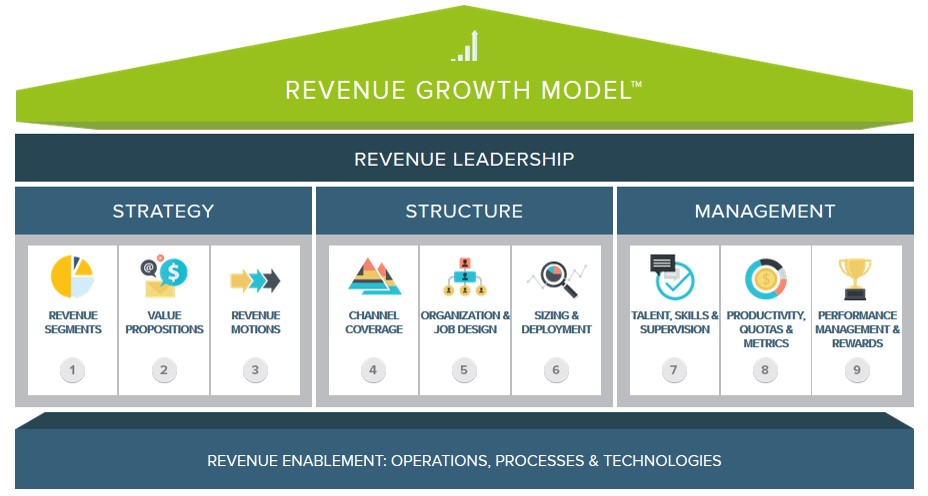Key Revenue Growth Planning Steps for Sales Compensation Success
Only 19 percent of participants in AGI’s annual sales compensation survey report complete alignment between the sales compensation program and company objectives. Why? Aligned sales compensation plans are dependent on many upstream planning decisions and associated data sets. Many companies unfortunately fail to deploy a robust business planning process and adequately connect the various data elements.
Revenue Growth Planning
A company’s business strategy is constantly on the move: new products, new markets, changing buyer behaviors and relentless competitor actions. Companies must continuously review and update their go-to-customer strategies to align to their business strategy. Using the Revenue Growth Model™, the strategy, structure and management decisions will eventually define the right type of sales compensation plan for each eligible sales job. Where is sales compensation? It is in the ninth—and last—pillar, Performance Management & Rewards.
Figure 1
Revenue Growth Model™
Business Planning Processes
Effective revenue growth planning relies on many data-intensive Strategy, Structure and Management planning processes. Upstream data feeds downstream processes. The need for real-time data is a compounding issue. In a recent sales operations survey, 87 percent of participants indicated that data integrity/clean-up was a major challenge. Successful companies invest in platform tools to effectively execute their planning processes.
Call to Action—7 Steps
Revenue growth leaders realize that they must employ an effective and efficient revenue planning and execution engine to achieve their revenue growth goals. To realize the full benefit of the sales compensation program, follow these seven mission-critical revenue growth-planning steps:
- Build the Revenue Plan—Be realistic, be bold. Establish the revenue goal for the operating period. Use historic data, use sales segment market research and add gut judgement. This number will inform the expense budget, it will define investments and it will establish the revenue goals for the sales compensation plan.
- Vet the Sales Expense Budget and Its ROI Impact—Determine sales force investments, including capacity planning and sales compensation costs.
- Use Account Segmentation & Potential to Identify Revenue Opportunities—Define specific coverage segments based on buyer needs and profitability to maximize productivity at the lowest cost via coverage model, capacity and territory potential.
- Analyze Sales Force Capacity—Deploy the optimal number of resources to maximize revenue within a cost-of-sales budget.
- Develop Territories—Structure balanced territories to equalize quota and sales compensation payout opportunity.
- Manage Quota Allocation—Allocate the revenue plan to each seller: Goals will motivate; payouts will reward.
- Adopt Sales Forecasting—Use ongoing forecasting to inform initial quota setting and mid-year revenue execution corrections.
Companies are constantly looking to improve their internal processes and tools to enable them to execute their go-to-customer models more effectively and efficiently. A singular best-in-class template does not exist. Models will vary based on industry, solution offering, company growth phase and go-to-customer model. Therefore, detailed planning processes must evolve over time. The key principles and interdependencies of these processes will always exist.
Read more in our whitepaper about how effective revenue planning drives sales compensation success.
How the Alexander Group Can Help
If you need help with sales compensation plan design or revenue growth planning, please contact us at the Alexander Group. We offer a range of solutions including revenue growth model design, sales operations planning, and sales compensation plan design.
Learn more about Alexander Group’s Sales Compensation practice.

Need Help?
Contact one of our Business Services practice leads to see how we can support your efforts.


